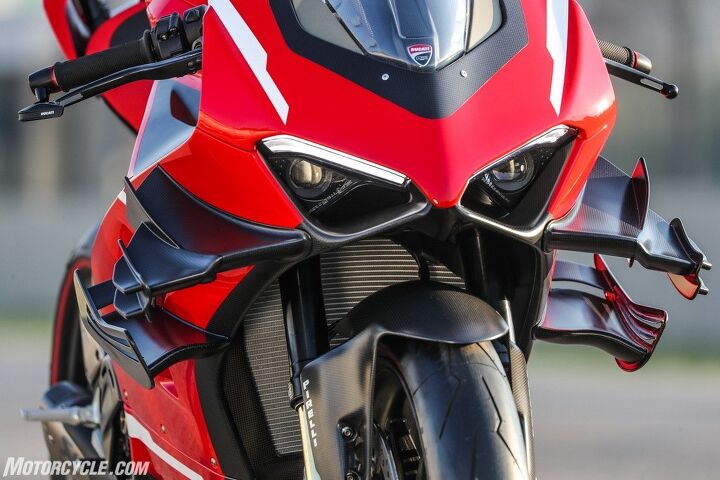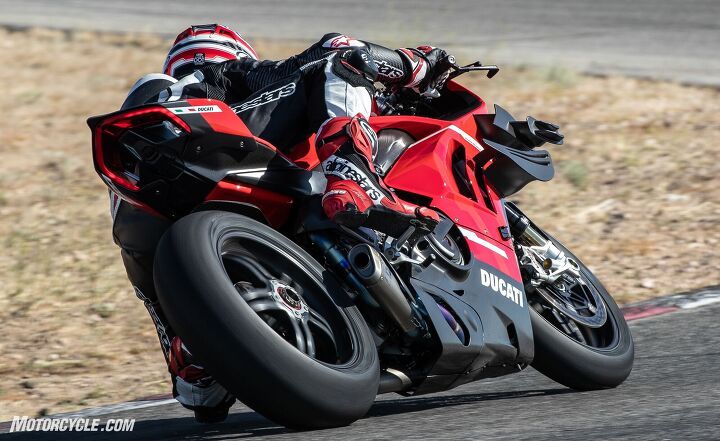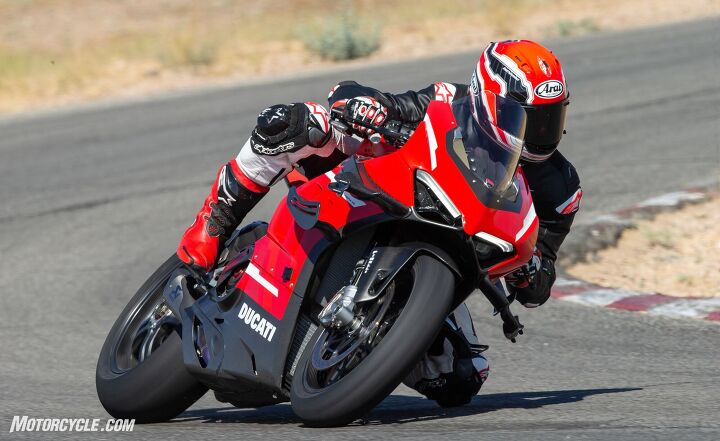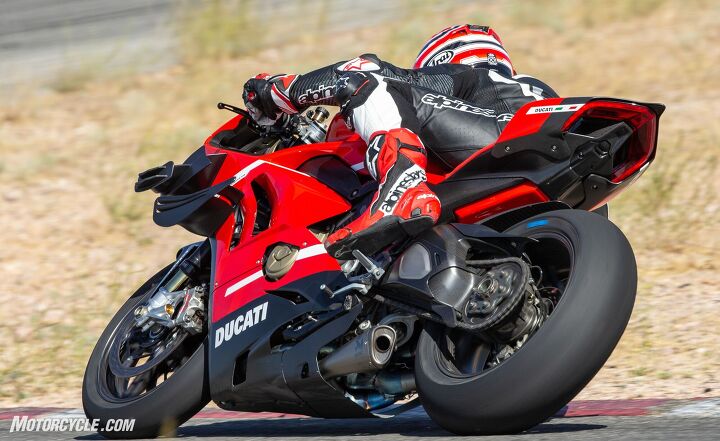As the world is flying past at a rapid pace, it’s all I can do to mentally process the rate of acceleration and the sheer speed of the Ducati Superleggera V4. When all 234 horses are unleashed from the mighty Desmosedici Stradale R, forget turn one – all of these thoroughbreds are hell-bent on launching me to the future, completely bending my perceptions of time, speed, and reality. I’m Captain Picard to the Superleggera’s Starship Enterprise, warp drive has just been engaged, and we’re about to leave behind streaks of starlight as we blast off. Doing it again and again is intoxicating, it’s breathtaking, and it’s simply incredible. This is what it’s like when Ducati engineers are allowed to let their imaginations run free and build the baddest machine they can. God bless ’em.
The Superleggera V4, of course, is the pinnacle of Ducati road bike engineering, as it represents the most powerful, fastest, and most advanced Ducati production bike ever. But this isn’t the first time Ducati has built a superleggera – or “super light” in Italian. The 1299 Superleggera represented the pinnacle of Ducati’s V-Twin. This time, we’re seeing the V4 platform freed to achieve its optimum potential, while still being legal to ride on the roads. And this lucky SOB was one of the select few invited to ride it.
Ducati 1299 Superleggera Review
But first, let’s put this bike into context. This is a motorcycle firmly placed in the most exclusive of categories. It makes 224 hp (at the crank) in standard trim and 234 hp if you add the Akrapovič race exhaust. Only 500 will be made, and here’s the kicker – each will cost $100,000. Yes, that’s one followed by five zeros.
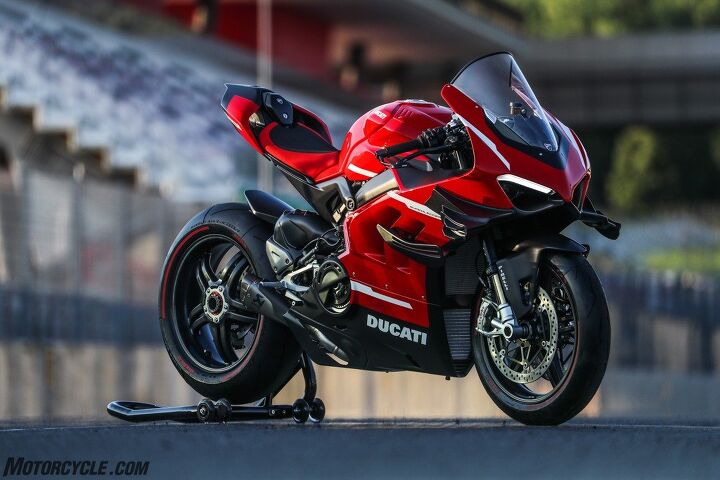
Is this the epitome of excess? Some might say so. But if you’ve ever wondered what Ducati can do to a road bike if allowed to take off the kid gloves and go full-hog, wonder no more. The Ducati Superleggera V4 is the answer.
If you’re the type who can freely toss that kind of money around then the Superleggera could conceivably be considered a bargain, if exclusivity coupled with premium performance is your thing. Further sweetening the pot, Ducati is offering all Superleggera V4 customers the chance to give the World Superbike Panigale V4 a shot, with full support from Ducati Corse. For 30 extremely lucky Superleggera V4 customers with proper riding skills (yes, you will be vetted), this experience goes one further, with the chance to try Ducati’s MotoGP contender.
The Complete Superleggera Walk-Through
Of course, we’re getting away from the namesake we have in front of us. The ultimate in weight savings and reduction, the Superleggera V4 employs every trick in the book to bring its weight down. Ducati claims a dry weight of 350.5 lbs with the stock exhaust, putting it 35 lbs lighter than the standard Panigale V4. The bike you see in these photos, and the bikes we’d be riding, is equipped with the Akrapovič racing exhaust, which brings dry weight down to 335.5 lbs.
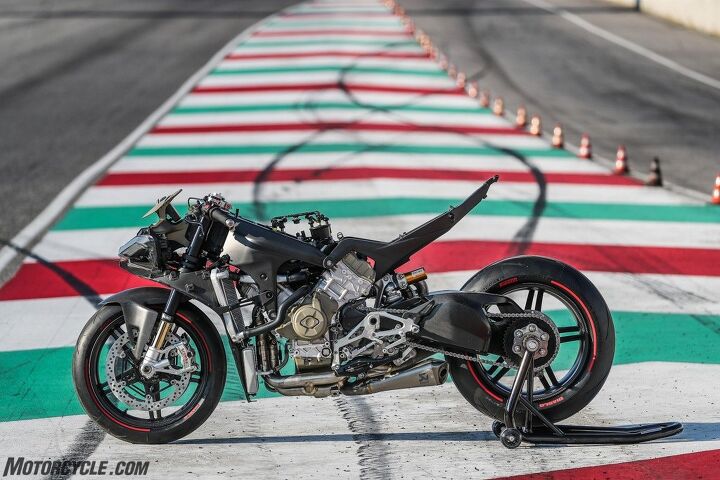
Sans the carbon fiber bodywork, what lies underneath is even more carbon fiber. The main frame, subframe, wheels, and even the swingarm are all carbon fiber. What’s more, all bolts that were steel before are now titanium. The net result is a 35-pound reduction in weight compared to the standard Panigale V4. Eat your heart out, Jenny Craig.
Obviously publishing dry weight is just marketing BS, since nobody rides a motorcycle without gas, a battery, oil, and other fluids, but Ducati isn’t publishing the Superleggera’s wet weight. Nonetheless, we estimate it to be in the 350 – 360-pound ballpark with the race exhaust (and it’ll probably be closer to 400 pounds with the standard exhaust). In any case, these are simply incredible numbers. For reference, the Kawasaki Ninja 400 tips the scales at 366 lbs (claimed). So, not only is the SL V4 lighter than a Ninja 400, but it also makes roughly five times the power.
So, how did Ducati achieve such substantial weight savings? The simple answer comes down to two materials: Carbon fiber and titanium. They’re everywhere. Come along, because we’re about to take a deep dive into all the components that make the Superleggera the tour de force that it is.
Chassis
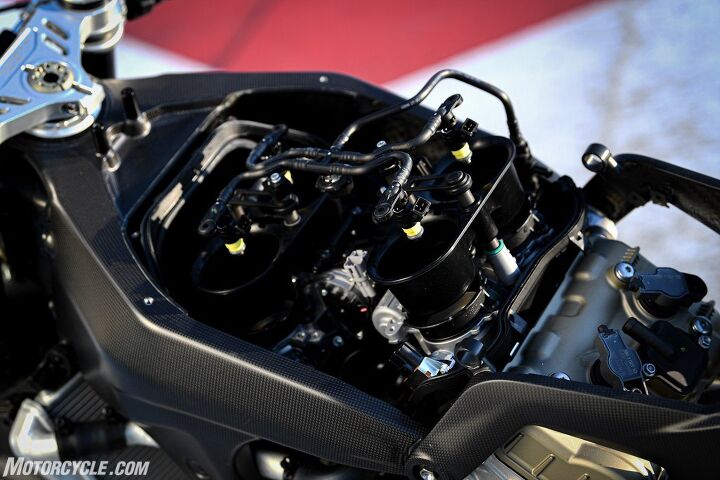
Designing a carbon fiber frame is no small task. Strength considerations aside, there’s also the matter of retaining a certain amount of chassis flex to give the rider feel and feedback.
Starting with the frame, the Superleggera V4 is the only homologated roadbike to have a frame made from carbon fiber (with titanium inserts in key areas). According to Carlo Ricci Maccarini, formerly of the chassis design teams for Ducati’s MotoGP and WSBK efforts, great lengths were taken to give the carbon frame similar flex characteristics to the standard Panigale, which itself has 5% more lateral flex than the original Panigale V4. Except the carbon piece is 2.6 lbs lighter.
The subframe, too, is carbon fiber and shaves another 2.6 lbs.
Even the swingarm is carbon fiber (with Ti inserts), cutting 2.0 lbs from the standard piece.
Then there are the wheels. Of course they’re carbon fiber, and collectively cut 7.5 lbs of rotating mass compared to the standard Panigale V4.

Lots to look at here, but the carbon fiber swingarm is the main thing. The single most expensive component of the Superleggera apart from the engine, the nearly $20,000 MSRP can net you nearly any other literbike equipped with some tasty mods! Carbon wheels are a no-brainer, as their benefits have long been documented. Other things to look at: the full titanium Akrapovič race exhaust, which cuts 13 lbs off the stock system and adds another 10 hp. The footpeg and its bracketry are machined pieces, the sprocket is aluminum, bolts titanium, and even the rear shock spring is titanium, too. Pirelli developed a specific compound of the Supercorsa SP specifically designed to handle the forces this bike makes. For this test, however, Pirelli equipped the bikes with its new 125/70-17 and 200/65-17 rear Diablo Slicks.
The Brembo Stylema calipers remain the same, but the pistons are drilled aluminum pieces for better cooling and reduced weight, with a special coating to reduce stiction.
On the suspension front, Öhlins provides the NPX25/30 pressurized fork, with machined billet bottoms to shave a few grams (while also looking extremely trick). The TTX36 shock gets GP valves for minimal stiction, leading to better bump absorption. A titanium spring helps shave precious weight. Compared to the Panigale V4, the TTX piece is 1.3 lbs lighter. Also of note: the Superleggera uses traditional, analog suspension instead of the electronic Öhlins bits on the Panigale V4 S. For such a motorcycle focused on light weight and racetrack hammering (which just happens to be street legal), traditional suspension is still the way to go.

If you look closely, you can see the titanium spring on the Öhlins TTX36 shock. But equally pleasing is how easy it is to reach the compression and rebound adjusters.
Other tidbits on the chassis side include an aluminum rear sprocket, titanium wheel nuts, and Regina ORAW2 chain, collectively shaving 1.3 lbs from the standard Panigale. Further, the rear suspension link, footpegs, and levers are also machined bits, the latter two pieces cutting another 1.5 lbs.
Engine
With a motorcycle like this, no stone goes unturned when searching for “adding lightness,” to borrow a line from famous F1 engineer Colin Chapman. This includes reexamining over 600 part numbers that make up the engine and looking for any areas where weight can be saved, even if it’s just a few grams. The Desmosedici Stradale R “light version” represents the lightest, most powerful edition of the V4 engine so far.
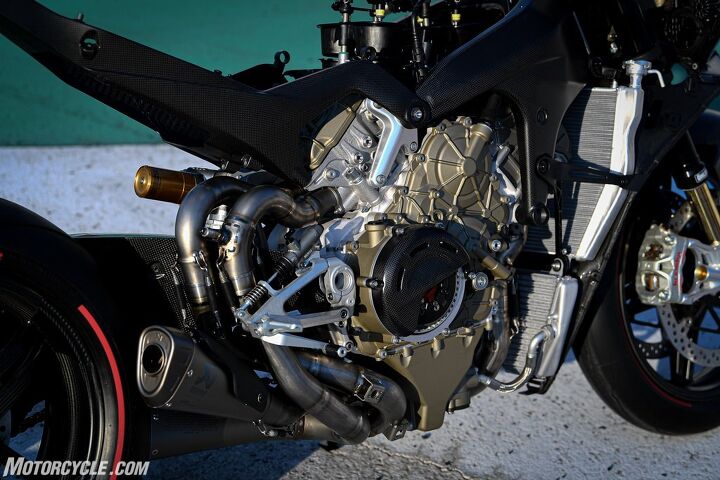
The mighty Desmosedici Stradale R “light version” features titanium bolts, connecting rods, and intake valves. Cams and starter have more holes and reduced widths, too. It’s incredible this thing can spin to nearly 16,000 rpm. That’s territory formerly reserved for 600cc motorcycles. Also, check out the huge radiator to keep all that heat under control.
For starters, all the standard steel bolts are replaced with titanium, even the ones for the camshafts, which themselves now have more holes for lightness and a narrower cross section to reduce weight. The starter gears, too, received the same treatment, with additional holes and reduced width.
Next, the oil pump assembly was completely redesigned and simplified, reducing the number of recovery pumps from three to two, yet sacrificing nothing in terms of pump efficiency. A lightened flywheel saves weight and lets the engine spin up easier. Titanium connecting rods and intake valves are titanium, and the pistons are aluminum (this hasn’t changed from the standard Panigale).
In all, Ducati says 42% of the engine components were redesigned in an effort to make the engine as light as possible, an effort that shaves an impressive 6.2 lbs from the standard Panigale V4 engine. Equally as impressive is the fact this engine has a 24-month, unlimited mileage warranty from Ducati, with valve adjustments recommended to be set every 15,000 miles (24,000km). How often – and how hard – a Superleggera owner is actually going to ride their motorcycle is a topic I’m sure will drum up conversation in the comments section…
For further weight savings the lucky Superleggera owner can opt for the road-legal Akrapovič titanium muffler and cut 5.5 lbs compared to the standard bike – or they can opt for the full titanium racing exhaust from Akrapovič, which then ups power from 224 hp to 234 hp at 15,500 rpm and 88 lb-ft at 11,750 rpm, all while shaving 13.3 lbs from the standard exhaust system.
It’s worth stressing, again, that these are crankshaft numbers. Nonetheless, when it all gets to the back tire we’re still talking about 200-plus horses. From a bike with headlights, turn signals, and a license plate. Nuts.
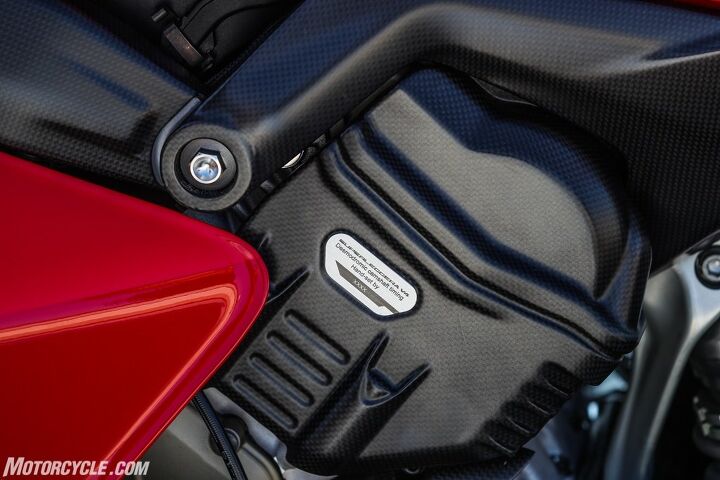
As an added touch, each Superleggera comes with this little tag under the valve cover, telling you the name of the person who set the timing of the desmodromic valves by hand.
Electronics
For the most part, the Superleggera retains the same electronics suite seen in the Panigale V4 S. This includes the latest generation of:
- ABS Cornering EVO
- Ducati Traction Control EVO 2
- Ducati Slide Control
- Ducati Wheelie Control EVO
- Ducati Power Launch
- Ducati Quick Shift up/down EVO2
- Engine Brake Control EVO
However, because of the SL’s lightness, the algorithms had to be tweaked a little to make it all work as they should. These are the kind of revisions you and I would likely take for granted, but are a necessary step in refining the package – especially one as exclusive as this.
As a quick refresher, the engine mapping actually dials back some of the power in the first two gears. This, combined with the Ducati Traction Control EVO 2, which is better able to predict spin oscillation and intervene faster and smoother, actually allows the rider to accelerate harder and maintain traction with the mechanical grip from the tires, without the need for the electronics to intervene at all. Further, when the tire does slip and the electronics intervene, the engine speed will actually decrease slightly to help the rider regain control. Typically under constant throttle, the opposite happens – a spinning tire will cause rpm to rise. This was a direct lesson learned from racing and applied to the Panigale line.

According to Ducati anyway, this is pretty darn close to the dash display Andrea Dovizioso uses on his Desmosedici GP20 MotoGP bike. The two most important bits of information being the giant gear position indicator front and center, and the lap time in the upper left. Electronic settings are to the right, and lap count to the left. There’s no tach, however. Just shift lights.
In a nod to the Superleggera’s track bias, the Riding Modes have been renamed. There’s Race A, which gives you full power. Race B dials back a little power in the first two gears. Sport, which dials things back even further for the road. Then five user modes, allowing for custom settings.
The biggest visible change on the electronics front is the RaceGP dash mode, which is only available if you use the full racing exhaust and the Ducati Data Analyzer/GPS unit. Inspired by the display Ducati MotoGP rider Andrea Dovizioso uses on his very own Desmosedici GP20, the RaceGP dash mode displays the current gear you’re in prominently with a huge number. To the right of the gear position are the electronics settings currently employed, and to the left are lap times, sector times, and lap number. The rev counter goes away, replaced with ascending shift lights to tell you when you’re getting close to redline (of course, it’s not hard to simply listen to the engine wailing underneath you to gauge shift points). If you prefer the standard dash with a tachometer and speed display, that’s still available.
Aerodynamics
Ah, yes. The wings. They’re quite prominent on the Superleggera, no? There’s a legitimate argument to be made that Ducati has spearheaded the aerodynamic movement in MotoGP, and the Superleggera is the beneficiary (some might say victim) of that development. Love’em or hate’em, the wings are here to stay.
In the case of the Superleggera, Marco Nicotra, Ducati’s Senior CFD Aerodynamicist, who joined the Ducati Corse race team in 2017, played a major part in developing the aero package for the SL. Those biplane wings (as opposed to the single plane seen on the V4 R and V4 S) are heavily derived from the Desmosedici GP16, before MotoGP changed the aero regulations the following year.
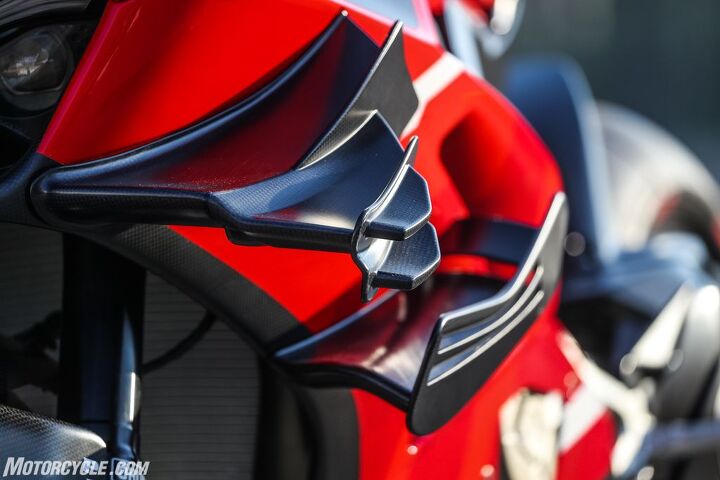
Ducati is unabashedly taking Formula 1-levels of aerodynamic development and employing those lessons on its motorcycles. Unlike the wing on your teenage neighbor’s Honda Civic, these actually work.
The intricate design of the two wings include strakes, tip winglets, louvers on the endplate, and a rear flap. If you follow Formula 1, you might notice many of these elements incorporated into the aerodynamics of the cars. This obviously isn’t for show. These elements combine to either redirect air, reduce drag, and/or increase downforce, both in a straight line and when the motorcycle is leaned over.
Because of those changes, the biplane wings on the Superleggera are actually more efficient than the ones on the Desmo GP19 Andrea Dovizioso and Danilo Petrucci raced last year. Most people think the immediate benefit of having more downforce on the front is being able to tame wheelies mechanically instead of electronically. And while this is true, the added downforce provides greater stability in all aspects of riding, from braking, to cornering, and obviously on corner exit.
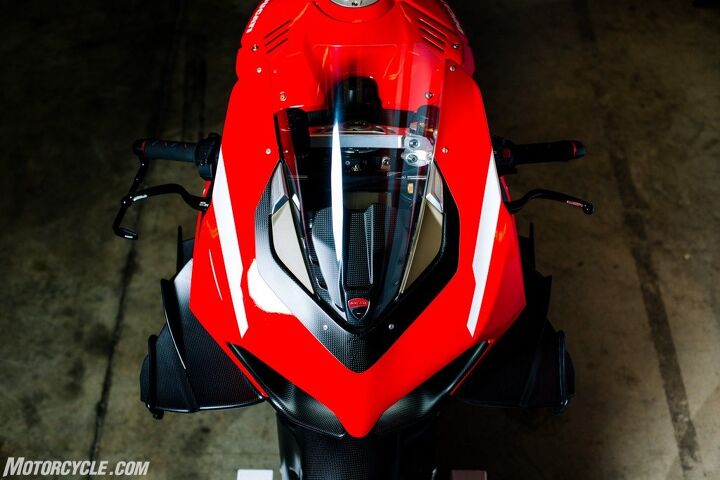
It might be hard to see from this overhead shot, but the Superleggera is almost laughably wide. Be careful should you decide to split lanes with one.
Also, at the speeds motorcycles like these are able to reach, without downforce the front could experience a form of floating, where it’s just barely skimming the ground (if it’s even on the ground at all) due to a small amount of lift created from the turbulent air being sliced at 150-plus miles per hour. Just take a look at this picture of Dani Pedrosa hurtling down the front straight at Mugello, pre wings, with both wheels a tiny bit off the ground. Winglets help keep that from happening.
For a greater visual representation of the wings, take a look at these two charts below:
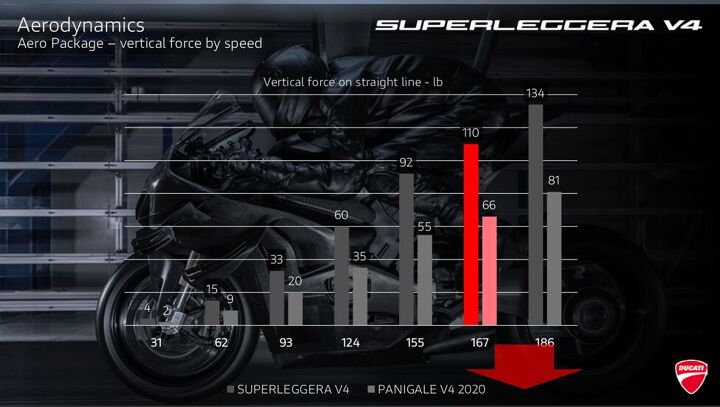
Here we have the downforce, in pounds, generated by the standard Panigale V4 (light grey) with its single plane wing and the Superleggera (dark grey) and its biplane wings at different speeds. While it’s easy to look at the right side of the chart and see that, at 167 mph or 186 mph you’re basically sticking the weight of a small human (Pedrosa, perhaps?) to the motorcycle, the reality is that very few people are going to reach those speeds. The point here is to highlight how much more downforce the Superleggera’s biplane wings generate – basically 66% more, from as low as 62 mph.
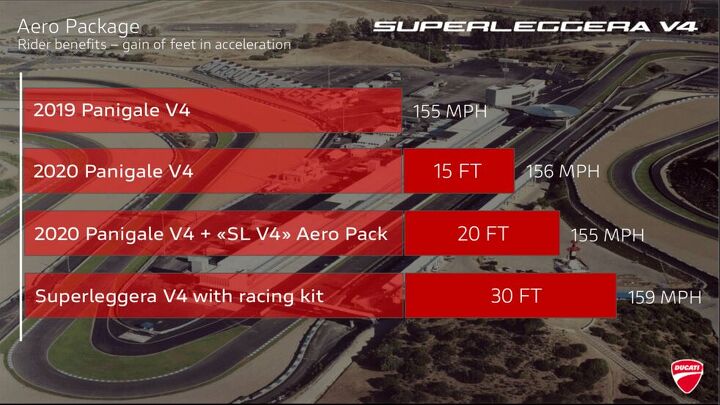
If you’re looking for tangible information to put the Superleggera’s performance into context, pay attention to this graphic. Using the 2019 Panigale V4, and the final turn at Jerez – a slow hairpin with an exit speed of approximately 55 mph leading onto the front straight – as a benchmark, we’re looking at speed and distance across the start/finish line. To start, the 2019 Panigale V4 crosses start/finish at 155 mph. With the 2020 Panigale V4, and its chassis tweaks and front wings, by the time it crosses start/finish it’s traveling 156 mph and has a 15-foot gap to the 2019 bike. Interestingly, the 2020 V4 equipped with the Superleggera’s aero package, has a trap speed identical to the 2019 bike at 155 mph, but has a gap 20 feet ahead. Now with the Superleggera V4, complete with the racing kit, by the time it exits the final turn at Jerez and crosses start/finish, its 159 mph trap speed is 4 mph greater than the 2019 bike, and its gap across the line is a massive 30 feet. Hopefully this helps put into context what a 35-pound weight reduction, a 25-horsepower bump (the standard Panigale is rated at 209 hp), and an emphasis on aerodynamics can do to a motorcycle’s performance.
What’s It Actually Like To Ride?
Still, despite the hype and attention built around this bike, there’s one thing left to find out: What’s it actually like to ride? It’s not hard to figure out that opportunities like this make up one of the highlights of a moto-journalist’s career. But there are heightened expectations. At $100,000, the Superleggera better be damn near perfect.
We were supposed to find out at the famed Mugello circuit in Italy, the perfect venue to let the Superleggera sing and to really feel the effects of the aerodynamics. But Covid-19 had other plans in store for us and those plans were unfortunately scrapped. Instead, the tight confines of Laguna Seca would replace the vast, flowing expanse of Mugello. The two tracks couldn’t be more different, but Laguna’s infamous Turn 1 would test the SL’s aero, as MotoGP bikes have been known to catch air as they crest the fast, uphill, left just past start/finish. Powerful motorcycles also loft the front end in the air as they drive up the hill heading towards the Corkscrew, which would prove to be another test for the aero and anti-wheelie strategies.
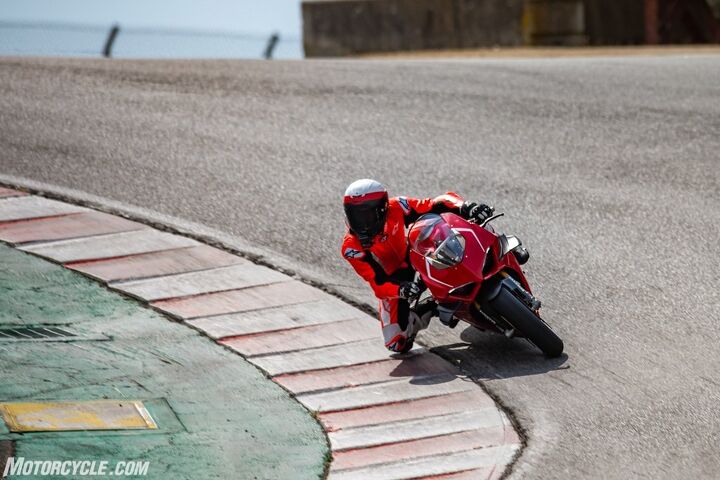
Not a bad day at the office when you get Laguna Seca and the Ducati Panigale V4 R all to yourself. Still, it’s a hell of a machine to have at your disposal to shake off the track-riding cobwebs!
Considering how many of us haven’t ridden motorcycles in anger since the lockdown started, track rust was a very real thing among the moto-journos in attendance. Yours Truly included. No worries – Ducati would have us ride the Panigale V4 R as our “warm-up” bike to help shake off the rust and get acclimated to the track and conditions. At “just” $40,000, the R is a comparative bargain! Conveniently, the V4 R would be a good benchmark to draw comparisons with the Superleggera. After the warm-up with the V4 R, I’d have two sessions with the SL, for a total of 12 laps. Obviously I would have preferred more, but beggars certainly can’t be choosers. Still, some interesting comparisons can be made.
Getting acclimated to the V4 R, it was borderline embarrassing how rusty I was with the whole track-riding thing. Motorcycles of this caliber demand that you’re on your game, as the near-16,000 rpm redline and 209 crankshaft horsepower are not to be taken lightly. Speed comes at you quickly as the engine spins up with ease. The tight confines of Laguna amplify that sensation of speed, too, as your vision has to adjust and focus on the road ahead. Still, it wasn’t easy.
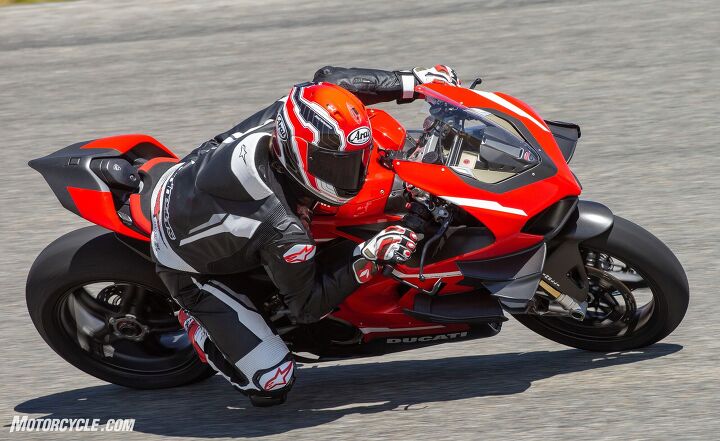
You don’t need 20/20 vision to notice the following action shots are not of me and not at Laguna Seca. Due to a photographer snafu at the intro, there were no usable action shots of the Suerleggera. So, photographer Kevin Wing came to the rescue, and Friend-of-MO Michael Vienne, proprietor of Championship Cycles, served as the model as I had a scheduling conflict.
Despite the rust, it did provide a good benchmark as it turns nicely, in no small part thanks to the forged wheels, and the brakes lock you down lickety-split. However, giving it the berries heading up the hill to the Corkscrew lofted the front wheel skyward as if the two wings up front had barely any effect. A gentle tap of the rear brake helped to bring the front down, but it was a frantic sequence of events as, once the front touched down, it was hard on the brakes to set up for the Corkscrew.
Hopping onto the Superleggera immediately after, all it took was a stroll down the hot pit lane to realize the massive difference in weight – just adjusting my leathers to get comfortable put an input on the bars that made the bike dart. The effects of the extreme lightness would continue to play out on track as the Superleggera tips in so effortlessly I had to adjust my turn-in points compared to the R model I had just ridden moments ago.
Of course, the ferocity with which the SL V4 accelerates is simply mind-boggling, as you’d expect when you combine more power with less weight – but that takes on a whole new meaning when you’re talking 234 horsepower and 350-odd pounds!
The kicker, as I’d discover once I returned to the pits after my first session, was that the bike was set to Race Mode B – meaning I actually had a slightly neutered bike in the first two gears! Looking back, I do recall instances where the amount of twist from my hand didn’t quite match up to the amount of power being delivered to the rear tire. For my final session, Race Mode A would be activated, unleashing the bike’s full potential.
Maybe it was the lunch break in between giving me a chance to gather my thoughts and shake off the rust, but everything seemed to click during the second session. Race Mode A was simply sublime. Telepathic can be a word that is overused when talking about the connection between the throttle and rear wheel, but in the case of the Superleggera V4 switched to Race Mode A, the link between my right hand and the rear tire was nothing less than, well… telepathic. Everything I asked for, it delivered, at a speed and pace I’ve never experienced before. I can only imagine this is the closest thing I’ll get to piloting a WSBK or MotoGP machine.
Once adjusted to the weight, or lack thereof, it’s just plain silly how late you can reach for the lever to activate the brakes – powerful Brembo Stylemas biting on 330mm rotors. With the reduction in rotating mass as great as it is, not only are turn-in points different, but braking markers are, too. You can toss it on its side so effortlessly, trailing on the brakes so precisely with your knee firmly on the deck, the closest thing I can compare it to is the toy-like effort and accuracy of the 275-pound Kramer HKR-EVO2. Except, with nearly three times the power, the Superleggera’s sheer acceleration is out of this world. Ducati didn’t just turn the dial to 11. They cranked it all the way to 20.
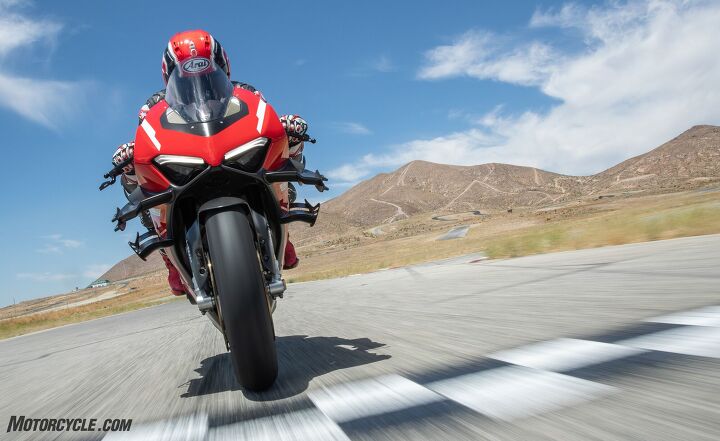
Aesthetic purists might scoff at the ghastly wings, but those who value function over form will appreciate them. In short, they work. Kevin Wing Photo
What about the aero, you ask? Even on the Superleggera, start/finish at Laguna is taken in fifth, throttle pinned if you’re brave enough. I wasn’t, but even half throttle over the hill is enough to make other bikes feel unstable and light in the front. On the Superleggera, my foot instinctually hovered over the rear brake but it really didn’t need to. In fact, other than the sheer speed (and sound), cresting turn one was surprisingly drama free. Same story cresting the hill leading to the Corkscrew. Throttle pinned, clicking through the gears, once again my right foot was at the ready, dabbing the brake out of habit. But unlike the V4 R, the SL never felt light or unstable in the front. For lack of any other explanation, credit for this added stability is at least partially down to the massively increased downforce from the wings compared to the R.
Walking the Walk
Typically, I tend to frame my reviews around some semblance of value, but when you’re dealing with a motorcycle with a price tag in the six-figures, any pretense of value is thrown out the window. In this case, the Ducati Superleggera V4 is graded purely on performance, and in that regard, it is simply extraordinary. The power. The agility. The sheer amount of no-holds-barred badassery that went into this thing. It’s incredible.
If you’re one of the 500 lucky people who gets to own one of these things, I salute you – and I do hope you thoroughly give it a good lashing at least once in your life. You’re doing yourself a disservice if you don’t. As I mentioned at the top of this story, for $100,000 this bike better be damn near perfect.
It is.
| 2020 Ducati Superleggera V4 | |
+ Highs
|
– Sighs
|
|
In Gear
|
| 2020 Ducati Superleggera V4 Specifications | |
|---|---|
| Engine | Desmosedici Stradale 90° V4, lightened, counter-rotating crankshaft, 4 Desmodromic timing, 4 valves per cylinder, liquid-cooled |
| Displacement | 998 cc |
| Bore x Stroke | 81 x 48.4 mm |
| Compression ratio | 14.0:1 |
| Horsepower | 224 hp at 15,250 rpm – 234 hp at 15,500 rpm with full racing exhaust (claimed) |
| Torque | 85.6 lb-ft at 11,750 rpm – 87.7 lb-ft at 11,750 rpm with full racing exhaust (claimed) |
| Fuel injection | Electronic fuel injection system. Twin injectors per cylinder. Full ride-by-wire elliptical throttle bodies with aerodynamic valves. Variable length intake system |
| Exhaust | 4-2-1-2 system, with 2 catalytic converters and 2 lambda probes |
| Transmission | 6 speed with Ducati Quick Shift (DQS) up/down EVO 2 |
| Primary drive | Straight cut gears; Ratio 1.80:1 |
| Gear Ratios | 1=38/14 2=36/17 3=33/19 4=32/21 5=30/22 6=30/24 |
| Final Drive | Regina ORAW2 chain ; Front sprocket 15; Rear sprocket in Ergal 42 |
| Clutch | Hydraulically controlled slipper dry clutch |
| Chassis | Carbon fiber “Front Frame” |
| Front Suspension | Fully adjustable 43 mm Öhlins NPX25/30 pressurized fork with TiN treatment, billet fork bottoms, lightweight springs, fully adjustable. 4.7 inches of travel. |
| Rear Suspension | Fully adjustable Öhlins TTX36 unit with GP valve and titanium spring. Carbon fiber single-sided swingarm. 5.1 inches of travel. |
| Front Wheel | 5-split spoke carbon fiber 3.50″ x 17″ |
| Rear Wheel | 5-split spoke carbon fiber 6.00″ x 17″ |
| Front Tire | Pirelli Diablo Supercorsa SP 120/70 ZR17 |
| Rear Tire | Pirelli Diablo Supercorsa SP 200/60 ZR17 |
| Front Brake | 2 x 330 mm semi-floating discs, radially mounted Brembo Monobloc Stylema R 4-piston callipers with Cornering ABS EVO |
| Rear Bbrake | 245 mm disc, 2-piston calliper with Cornering ABS EVO |
| Instrumentation | 5″ TFT colour display |
| Dry weight | 350 pounds, 335.5 pounds with racing kit (claimed) |
| Seat height | 32.9 inches |
| Wheelbase | 58.3 inches |
| Rake/Trail | 24.5°/3.94 inches |
| Fuel Capacity | 4.23 gallon |
| Safety Equipment | Riding Modes, Power Modes, Cornering ABS EVO, Ducati Traction Control (DTC) EVO 2, Ducati Wheelie Control (DWC) EVO, Ducati Slide Control (DSC), Engine Brake Control (EBC) EVO, Auto tire calibration |
| Standard Equipment | Ducati Power Launch (DPL), Ducati Quick Shift (DQS) up/down EVO 2, Full LED lighting with Daytime Running Light (DRL), GPS module, Lap Timer EVO 2, PIT limiter, Ohlins steering damper, Quick adjustment buttons, Lithium-ion battery, Auto-off indicators, Chassis in carbon fiber, Carbon fiber fairings, Carbon fiber wheels, Carbon fiber mudguards, Biplane wings in carbon fiber, High-flow air filter, Type approved Akrapovič silencer in titanium |
| Additional Equipment | Front and rear paddock stands, Battery maintainer, Race Kit: Akrapovič Titanium racing exhaust, Machined mirror block-off plates, License plate mount removal plug, Swing arm guard, Carbon fiber clutch cover,Ducati Data Analyzer+ (DDA+) with GPS module, Side stand removal kit, Front and rear lights removal kit, Bike cover. |
| Optional Equipment | Ducati Multimedia System (DMS), Anti-theft |





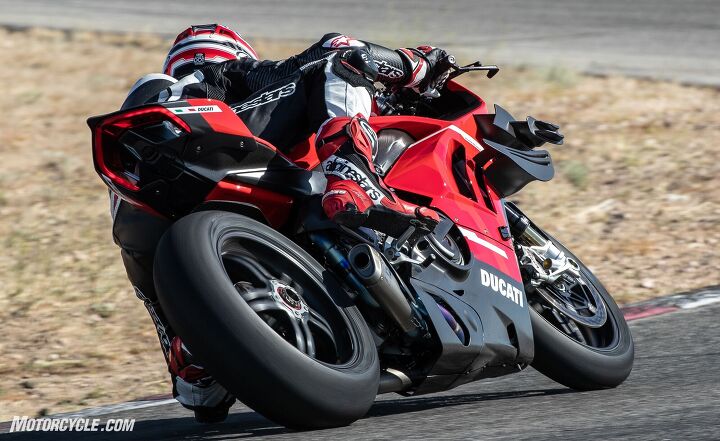


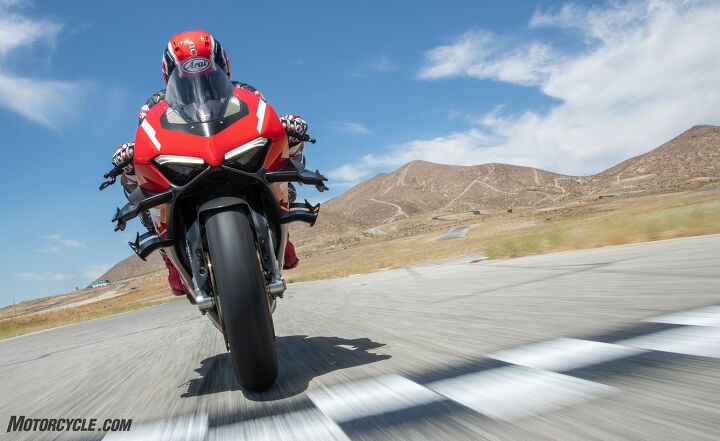
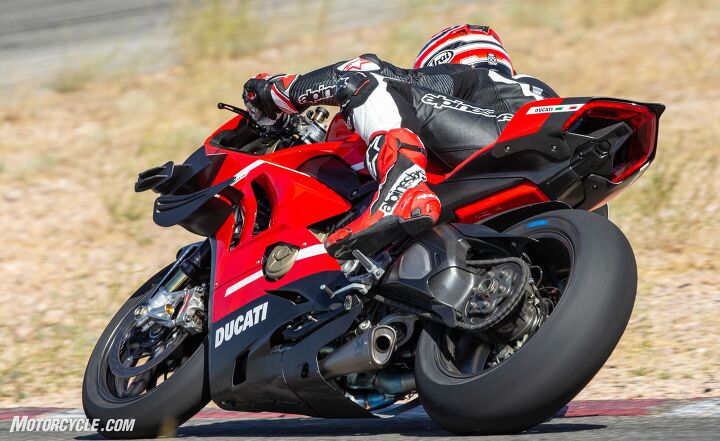








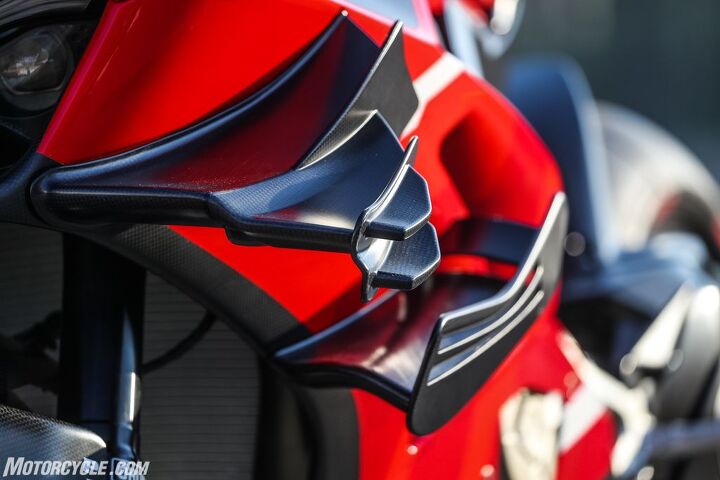


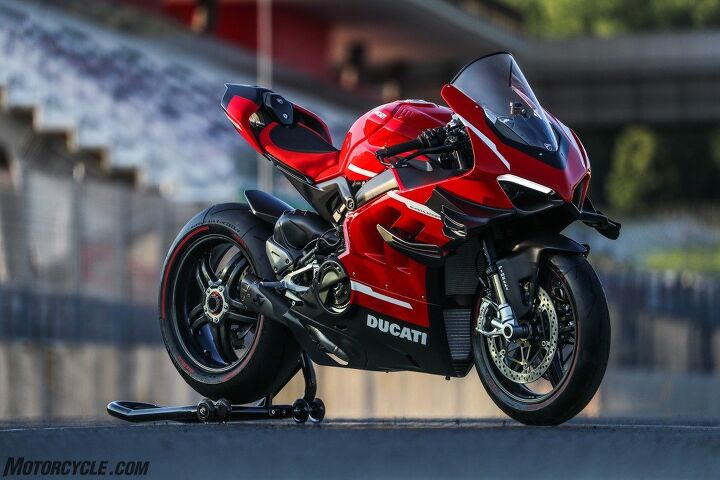







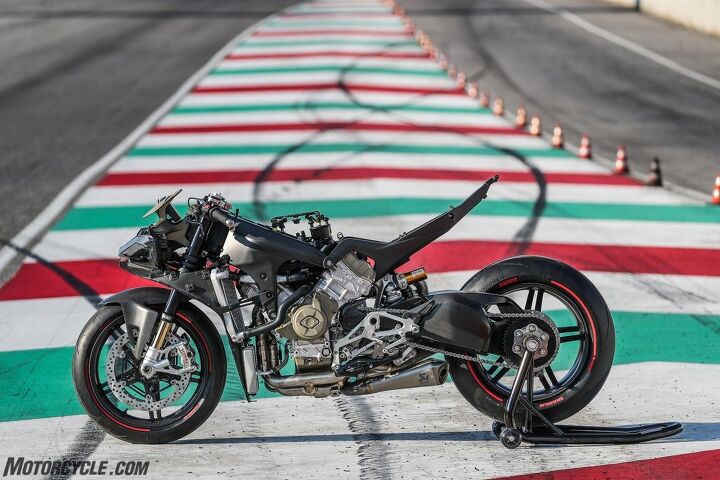


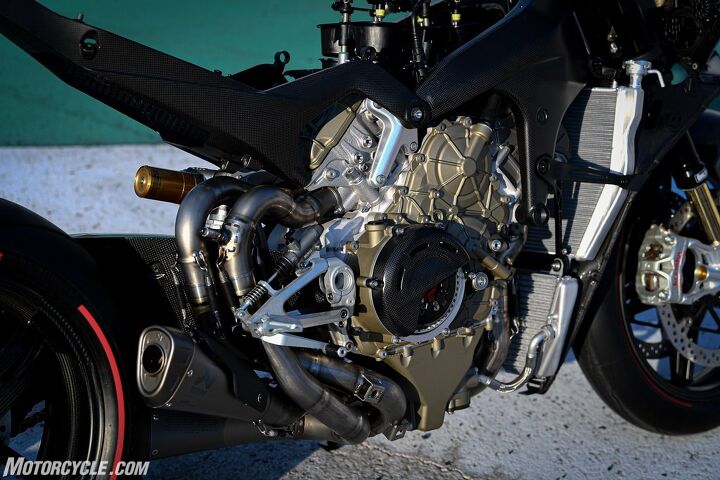


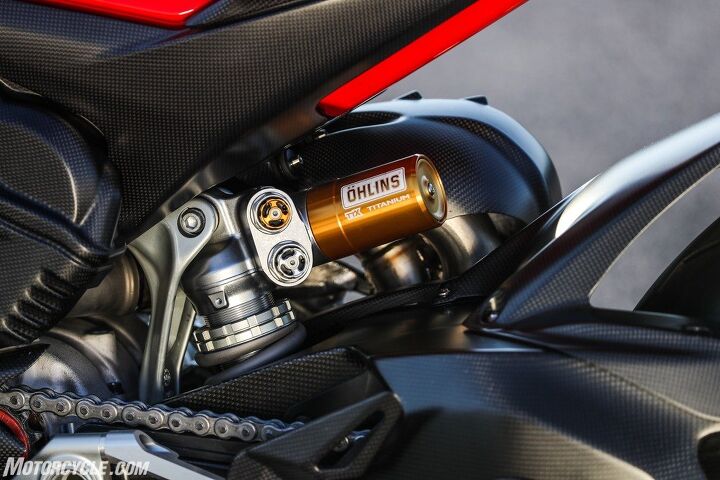

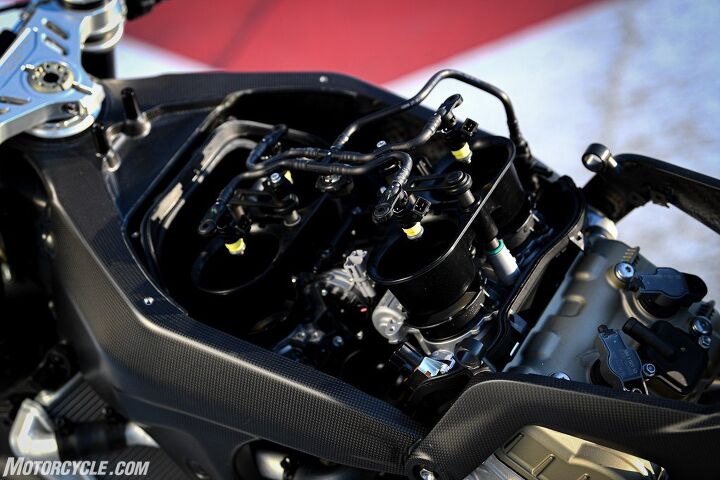

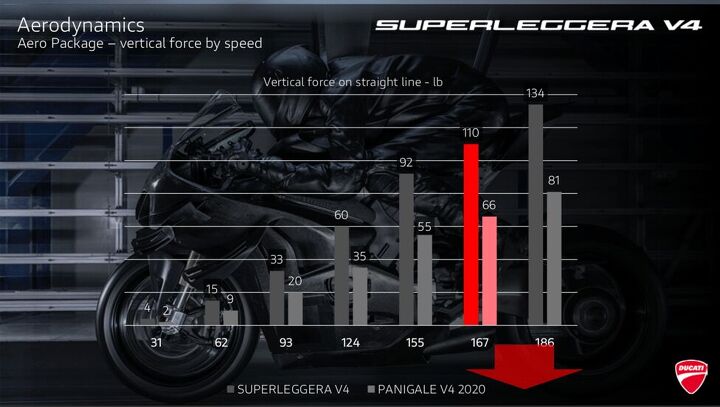
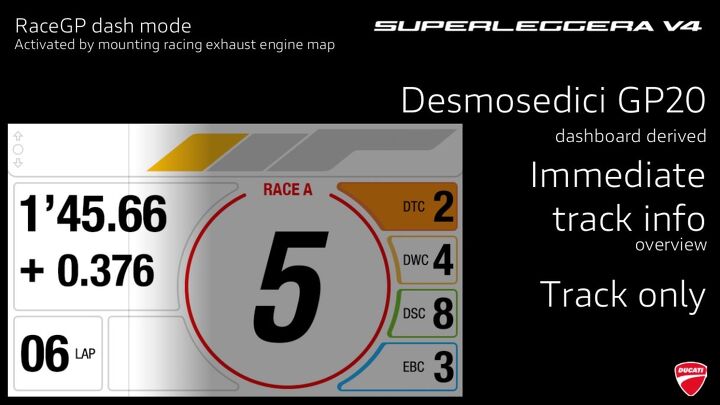
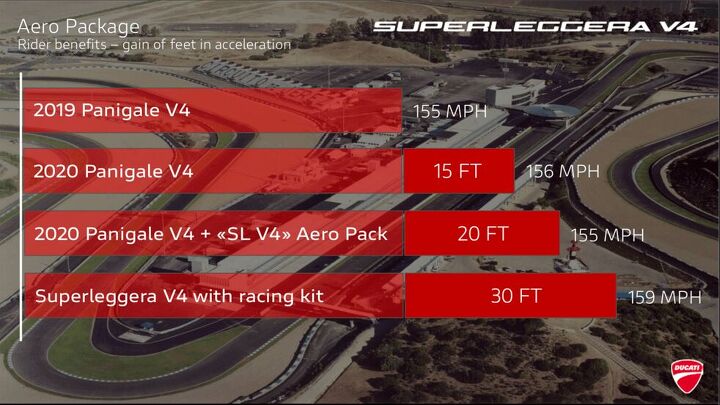
We are committed to finding, researching, and recommending the best products. We earn commissions from purchases you make using the retail links in our product reviews. Learn more about how this works.
Become a Motorcycle.com insider. Get the latest motorcycle news first by subscribing to our newsletter here.
The post 2020 Ducati Superleggera V4 Review – First Ride appeared first on Motorcycle.com.
【Top 10 Malaysia & Singapore Most Beautiful Girls】Have you follow?

